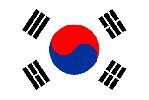 |
|
 |
|
Donggureung (the east nine tombs) was the burial ground of some of the joseon dynasty (1392 - 1910) kings and queens. Although there are nine mounds visible, there are actually 6 kings, 9 queens and a posthumously declared king and queen buried here. The earliest tomb was constructed here in 1403 and the latest in 1848. One historical highlight is the tomb of the dynastic founder King Taejo. All of the tombs are constructed in the same genearly style, with a three-part sequence that includes a ceremonial gate at the front, a T-shaped sacrificial hall at the center, and a larg mound in the rear, the top of which is covered with smaller mounds and stonework.
Here I present pictures from four of the tombs:
1: Hyeonneung, which is the tomb of king Munjong (5th king) and queen Gwon. The raised walkway leading to the shrine has an extra right-angle turn. In addition to the usual stone fence, King Munjong's mond has a 12 sided retaining wall inside the fence.
2: Geenwonneung is the tomb of king Taejo, the first king of the Joseon dynasty. Taejo originally was known as Yi Seonggye, founded the dynasty in 1392. He resigned from 1392-1398 and went into retirement. At his death in 1408 his fifth son King Taejong constructed his tomb. Unlike the other tombs, the stone horses stand directly behind, rather than beside the civilian and militay leaders.
3: Gyeongneung is the tomb of King Heonjong, the 24th ruler of the Joseon dynasty, is the sole example of a tomb with three mouds enclosed inside the same wall. Heonjong became king at the age 7 and married queen Kim at age 11. Queen Kim died when the king was 16. At 18 he married Queen Hong. Heonjong reigned for 15 years (1834-49) and died at age 22. Both queens are buried in separate mounds to the right of the kings tomb. Queen Hong was the last member of the royal family to be buried at Donggureung. She died in 1904 at the age 73.
4: Hyereung is the tomb of queen Sim, the first queen of King Gyeongjong, the 20th ruler of the Choson dynasty (ruled 1720-24) Gyeongjong was the son of the infamous concubine Jang Huibin. He suffered lengthy illness during his reign as a result of harm in 1718 before her husband became king.
Click on the thumbnails to have a larger version